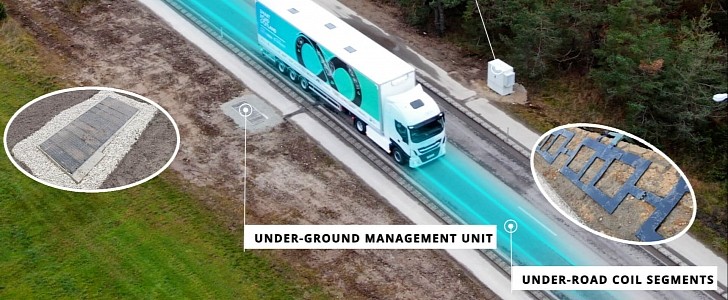Charging EVs wirelessly while driving is an old dream, but this could soon become a reality in Michigan. The project of an EV charging road was announced last year by Michigan Gov. Gretchen Whitmer. Although the initial plans were for the road to be completed in 2023, a new report indicates the project will become operational in 2025.
No matter how convenient it is to charge your electric vehicle at home overnight, charging it while driving is way cooler. This allows carmakers to use a much smaller Li-Ion battery, while the range anxiety would be a thing of the past. But is it really possible to have electric vehicles charging while driving down a road?
In theory, this is possible, and a pilot project was announced last year to make it a reality in Michigan. The project involves installing both dynamic and stationary wireless EV charging tiles on a one-mile (1.65-km) stretch of road in downtown Detroit. According to an article on SAE.org, MDOT is currently conducting a feasibility study on electrifying a section of Michigan Avenue and/or 14th Street in Detroit’s Corktown neighborhood.
The project, backed by Ford, Michigan utility provider DTE Energy and the City of Detroit, is estimated to cost $1.9 million. A press release published in February by Whitmer’s office showed that the project would use the technology developed by the Israeli firm Electreon and was projected to be completed by 2023. Electreon CEO Oren Ezer confirmed for SAE.org that the project will now be completed in 2025 instead.
Electreon technology uses rubber-coated copper coils embedded into the road surface. The magnetic induction generated when an electric current is applied is used to charge an EV either driving on the surface above or parked. This is not much different than the wireless charging pads used for mobile phones, smartwatches, and other gadgets. The technology can be used on various vehicles, from passenger cars to heavy trucks and buses.
The driving speed has a negligible effect on the charging performance, Electreon explained to SAE.org. So far, the company has tested its receivers up to a speed of 49.7 mph (80 kph). Speed affects how long the charging road needs to be, though. For instance, a commercial truck with five receivers traveling at 37 mph (60 kph) needs 37 miles (60 km) of electrified road to fully charge the battery. If the vehicle is traveling at 12.4 mph (20 kph), only 12.4 miles (20 km) of electrified road are needed to fully charge the battery.
In theory, this is possible, and a pilot project was announced last year to make it a reality in Michigan. The project involves installing both dynamic and stationary wireless EV charging tiles on a one-mile (1.65-km) stretch of road in downtown Detroit. According to an article on SAE.org, MDOT is currently conducting a feasibility study on electrifying a section of Michigan Avenue and/or 14th Street in Detroit’s Corktown neighborhood.
The project, backed by Ford, Michigan utility provider DTE Energy and the City of Detroit, is estimated to cost $1.9 million. A press release published in February by Whitmer’s office showed that the project would use the technology developed by the Israeli firm Electreon and was projected to be completed by 2023. Electreon CEO Oren Ezer confirmed for SAE.org that the project will now be completed in 2025 instead.
Electreon technology uses rubber-coated copper coils embedded into the road surface. The magnetic induction generated when an electric current is applied is used to charge an EV either driving on the surface above or parked. This is not much different than the wireless charging pads used for mobile phones, smartwatches, and other gadgets. The technology can be used on various vehicles, from passenger cars to heavy trucks and buses.
The driving speed has a negligible effect on the charging performance, Electreon explained to SAE.org. So far, the company has tested its receivers up to a speed of 49.7 mph (80 kph). Speed affects how long the charging road needs to be, though. For instance, a commercial truck with five receivers traveling at 37 mph (60 kph) needs 37 miles (60 km) of electrified road to fully charge the battery. If the vehicle is traveling at 12.4 mph (20 kph), only 12.4 miles (20 km) of electrified road are needed to fully charge the battery.






